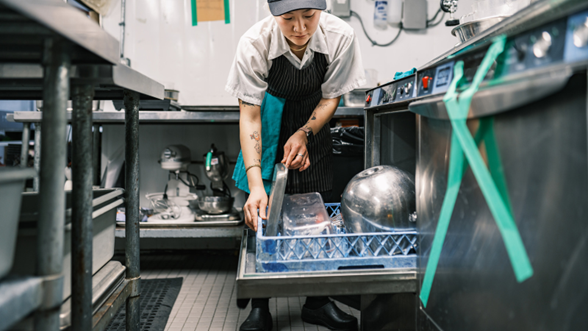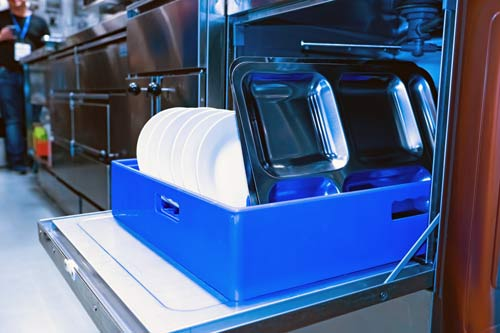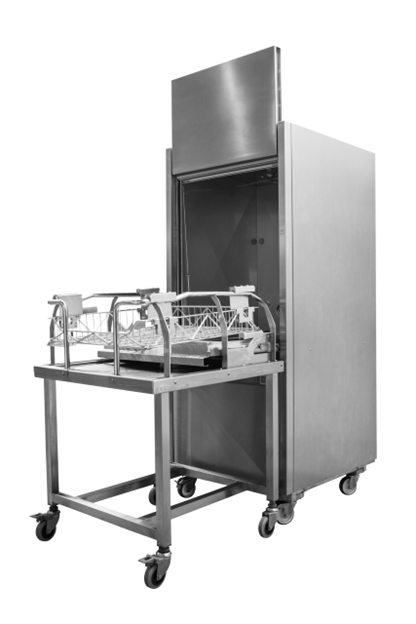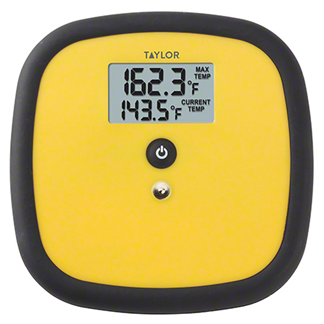What Temperature Should a Restaurant Dish Machine Reach?
What Temperature Should a Restaurant Dish Machine Reach?
Running a restaurant is no small feat. It’s a hectic balance of juggling orders, customer preferences, a welcoming atmosphere, short wait times, and more. In such a busy setting, the last thing you need is a dishwasher on the fritz, spewing out half-cleaned dishes. But how can you be sure your dish machine is hitting the right temperature for sanitization—and what do you do if it’s not?
At State Cleaning, we lease, service, and provide chemicals for commercial dish machines. When you’re busy running a restaurant, we know that the last thing you want is to scramble to figure out the problem with an uncooperative dishwasher.
To help you keep your dishwasher functional and your kitchen clean, we’re going to explain the difference between low-temp and high-temp dishwashers, which temperature each should reach, how to check the temperature to verify dish sanitization, and what to do if temperatures are too low. After reading, you’ll know how to keep tabs on dishwasher performance and what to do in the case of an issue.

Low-Temp vs. High-Temp Commercial Dishwasher
Before you determine what temperature your dish machine should reach, you must first verify whether you have a low-temp or high-temp dishwasher.

A low-temp dishwasher still gets hot, but it relies on a chemical like chlorine to sanitize dishes instead of heat. Low-temp dishwashers do not require the use of a condensate hood nor will they need extra breaker space.
Meanwhile, a high-temp dishwasher only uses heat to sanitize dishes rather than using any sort of sanitizing chemical. High-temp dishwashers commonly use condensate hoods, but there are also ventless high-temp options. Additionally, high-temp dishwashers use additional breaker space and need kitchens that have more features to support them overall.
What Temperature Should a Low-Temp Dishwasher Reach?
Because heat sanitization isn’t their function, low-temp dishwashers are required to reach a lower temperature than high-temp dishwashers. However, it’s still important that they reach these temperatures to effectively sanitize dishes.

Even though they’re not heat-sanitizing, low-temp dish machines should reach a temperature of at least 120 ºF for wash and rinse cycles. With low-temp machines, not only will you need to monitor the temperature, but you’ll also need to use test kits to ensure that your chemical sanitizer is dispensing at the correct concentration.
What Temperature Should a High-Temp Dishwasher Reach?
On the other hand, high-temp dishwashers need to reach higher temperatures in order to effectively reduce pathogens to a safe level.

During a rinse cycle, high-temp dishwashers should reach a temperature of 165 ºF for a stationary, single-temperature machine and 180 ºF for any other type of high-temp machine. These temperatures ensure that dishes reach the required internal temperature of 160 ºF.
However, you also don’t want your dishwasher to get too hot. If your machine reaches a temperature of 194 ºF or higher, the water will start to evaporate, reducing the strength of sanitization. Keep an eye on temperatures at both ends of the spectrum, and your facility will be cleaner for it.
How to Check Restaurant Dishwasher Temperature
It can be tempting to just assume your commercial dishwasher is functioning properly, especially when you’re busy and don’t notice any obvious problems. However, for the safety of your customers, for the reputation of your restaurant, and for the sake of passing health inspections, it’s important to keep an eye on dishwasher temperatures.

For both low-temp and high-temp dish machines, you can do this by sticking a heat-sensitive test strip onto a dish. After the cycle runs, check the strip. If it changes color, the proper temperature has been met. If not, your dishwasher isn’t reaching the right temperature.
You should also do this with chemical test strips in low-temp dishwashers. This way, you can verify proper chemical concentrations in hand with proper temperatures.
What to Do If Restaurant Dishwasher Temperature is Too Low
If you test your dishwasher and find that the temperature is off, it’s important to take action.

Often, a cool dishwasher is the sign of a faulty heating element, an issue with the wiring, or a problem with the water supply. Assess the dishwasher to determine whether everything is intact or if there are signs of damage. You can refer to the dishwasher manual or manufacturer directions for next steps, but you may need to call your service provider or another expert to schedule repairs.
If you’re ever unsure of whether there’s an issue or what to do, reach out to a repair service. The cost savings of fixing a problem yourself can be desirable, but not so much when it leaves the issue to stagnate or worsen.
Learn More About Which Commercial Dishwasher Will Perform Best in Your Facility
Your restaurant deals with different problems every day; understanding how to manage your dishwasher helps you to manage problems. Now that you know what temperature your dishwasher should be at, watch the video below to learn about choosing the best dish machine for your facility.








